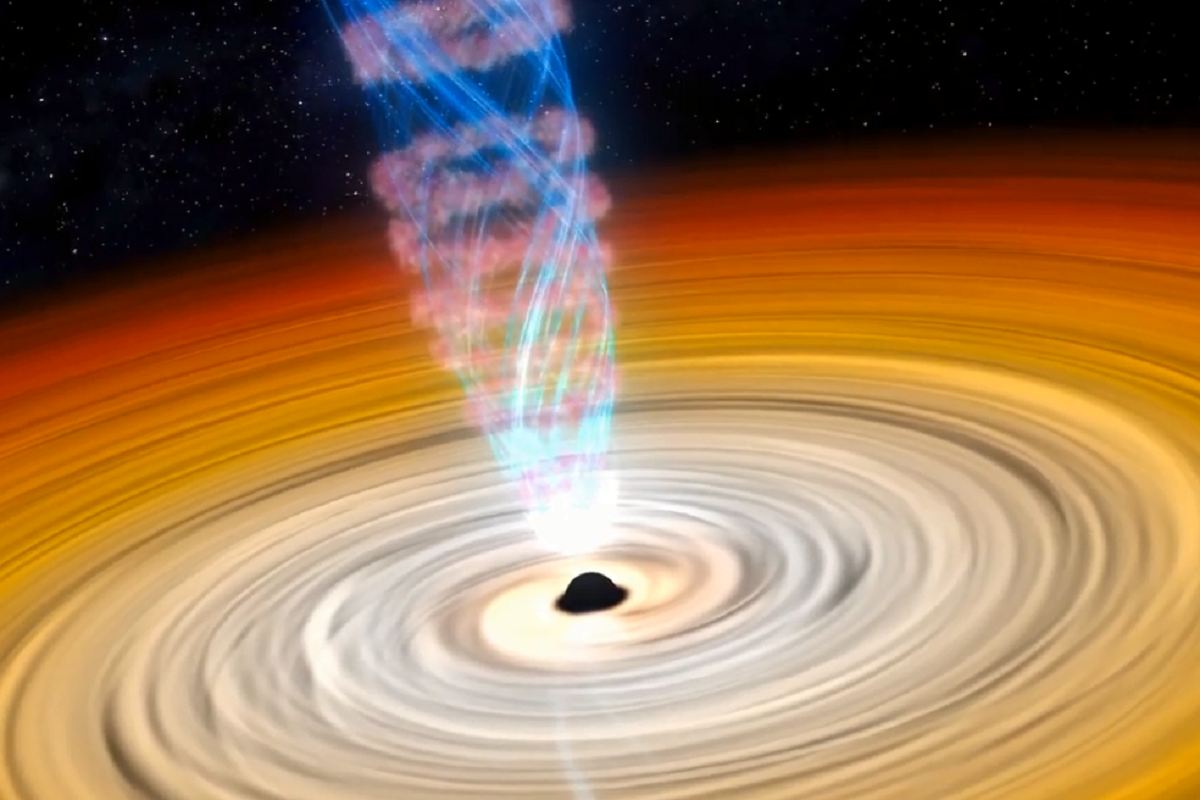St Petersburg University scientists explain the behaviour of the optical emission of blazars and describe the structure of their jets

Researchers from St Petersburg University have analysed data from optical telescopes covering more than eight years and managed to explain the mechanism of polarisation plane rotations in blazars. The research findings are published in MNRAS. It is a peer-reviewed scientific journal covering research in astronomy and astrophysics and published by the Royal Astronomical Society.
Dmitry Blinov is a co-author of the article and Senior Research Associate in the Department of Astrophysics, St Petersburg University and Insitute of Astrophysics, FORTH. He notes that researchers have been studying the optical polarisation from active galactic nuclei for more than 50 years. Some of the first academic papers on this topic were published back in the 1960s by Vladimir Hagen-Thorn, Professor in the Department of Astrophysics, St Petersburg University, and Viktor Dombrovskiy, Associate Professor in the Department of Astrophysics, Leningrad State University.
In the Universe, the main material is concentrated in galaxies with hundreds of billions of stars: there are about 200-400 of them in the Milky Way. At the centre of galaxies there are supermassive black holes, whose mass ranges from millions to billions of those of the Sun. Around black holes there is a large number of stars, gas and dust, which, being too close to the black hole, ‘fall’ into it. However, a black hole cannot ingest these completely and throws out part of the matter into intergalactic space in the form of extremely fast plasma jets.
The best objects for studying this phenomenon are blazars. They are active galactic nuclei with very high luminosity, whose plasma flow (jet) is directed towards the Earth at an angle of no more than 15 degrees. Such objects are the main sources of cosmic gamma rays, the nature and properties of which are understudied. Additionally, blazars puzzle astronomers by other phenomena, including the rotation of polarisation plane.
The polarisation plane of a wave is the plane in which a vector (for example, the electric field vector) oscillates and changes. In the figure below, the oscillations of the electric vector are in blue; the polarisation plane is in red.
The light that we see in nature, as a rule, consists of many such waves directed in different directions. In this case, the orientation of polarisation is random (in the figure on the left). Fully polarised light (in the figure on the right) propagates with the oscillations of the electric vector in only one plane. Such a phenomenon can be observed in some lasers. However, physical processes mainly create partially polarised light, while electromagnetic waves in a light beam often oscillate along one of the directions. For example, the figure in the middle shows electromagnetic waves in a beam of partially polarised light directed towards the reader. It is this kind of light that scientists observe when studying blazars. For this purpose, they study active galactic nuclei through a telescope with a special polarising filter, similar to sunglasses, which transmits oscillations only in one plane.
Decades of observations have testified that the polarisation plane of visible light in blazars sometimes rotates. Scientists have put forward several hypotheses that could describe the mechanism of such rotations, but none of them have had sufficient evidence. The research group from the Laboratory of Observational Astrophysics at St Petersburg University drew attention to one of the theoretical models. It was proposed back in 2010 in an academic paper. Researchers from St Petersburg University also took part in that study. It considered a rotation of the polarisation plane and predicted that such rotations should coincide with repeated gamma ray bursts.
The research group from St Petersburg University tested this hypothesis in collaboration with scientists from: the Boston University Institute for Astrophysical Research, the Max Planck Institute for Radio Astronomy; and other research institutions. They analysed publicly available data from: the Fermi Gamma-ray Space Telescope, which had observed one of the most active blazars 3C 279; the St Petersburg University Observatory; the Crimean Astrophysical Observatory; the Perkins telescope; and others.
‘We have compared the results of numerous observations of the polarisation of optical emission from blazar 3C 279 with open data from the Fermi Gamma-ray Space Telescope. It has been regularly scanning the entire sky since 2008 and showing gamma-ray flux distribution. We have managed to find a pattern of bursts in this blazar, which has repeated at least three times along with the rotations of the optical polarisation. This confirms the previously proposed model explaining rotations of polarisation,’ says Dmitry Blinov.
Additionally, based on the data obtained, the researchers have managed to describe the structure of the inner part of the jets. It is found that the fast spine, the centre of the jet, is surrounded by a slower sheath, which consists of ring condensations. When a plasmoid moves along the spine of the jet at high speed, it scatters low-energy photons from the sheath to energies of the gamma ray band. This causes the bursts that the scientists have observed. Since the ring-shaped structures of the sheath have been stable over the years of observations, such bursts have repeated several times.
The research findings have become the basis for 3D animation, which gives an idea of the processes taking place in the inner parts of active galactic nuclei. According to Dmitry Blinov, in the future, similar patterns of bursts in the gamma band might help clarify other issues. For example, according to one of the hypotheses, it is jets with fast spines and a slow sheaths that can produce fundamental cosmic particles – neutrinos. Repeating patterns of bursts might indicate blazars that emit cosmic neutrinos.

